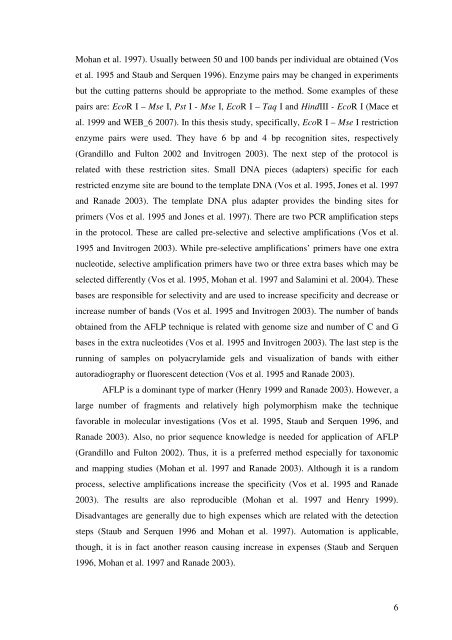determination of genetic diversity between eggplant and its wild ...
determination of genetic diversity between eggplant and its wild ...
determination of genetic diversity between eggplant and its wild ...
Create successful ePaper yourself
Turn your PDF publications into a flip-book with our unique Google optimized e-Paper software.
Mohan et al. 1997). Usually <strong>between</strong> 50 <strong>and</strong> 100 b<strong>and</strong>s per individual are obtained (Vos<br />
et al. 1995 <strong>and</strong> Staub <strong>and</strong> Serquen 1996). Enzyme pairs may be changed in experiments<br />
but the cutting patterns should be appropriate to the method. Some examples <strong>of</strong> these<br />
pairs are: EcoR I – Mse I, Pst I - Mse I, EcoR I – Taq I <strong>and</strong> HindIII - EcoR I (Mace et<br />
al. 1999 <strong>and</strong> WEB_6 2007). In this thesis study, specifically, EcoR I – Mse I restriction<br />
enzyme pairs were used. They have 6 bp <strong>and</strong> 4 bp recognition sites, respectively<br />
(Gr<strong>and</strong>illo <strong>and</strong> Fulton 2002 <strong>and</strong> Invitrogen 2003). The next step <strong>of</strong> the protocol is<br />
related with these restriction sites. Small DNA pieces (adapters) specific for each<br />
restricted enzyme site are bound to the template DNA (Vos et al. 1995, Jones et al. 1997<br />
<strong>and</strong> Ranade 2003). The template DNA plus adapter provides the binding sites for<br />
primers (Vos et al. 1995 <strong>and</strong> Jones et al. 1997). There are two PCR amplification steps<br />
in the protocol. These are called pre-selective <strong>and</strong> selective amplifications (Vos et al.<br />
1995 <strong>and</strong> Invitrogen 2003). While pre-selective amplifications’ primers have one extra<br />
nucleotide, selective amplification primers have two or three extra bases which may be<br />
selected differently (Vos et al. 1995, Mohan et al. 1997 <strong>and</strong> Salamini et al. 2004). These<br />
bases are responsible for selectivity <strong>and</strong> are used to increase specificity <strong>and</strong> decrease or<br />
increase number <strong>of</strong> b<strong>and</strong>s (Vos et al. 1995 <strong>and</strong> Invitrogen 2003). The number <strong>of</strong> b<strong>and</strong>s<br />
obtained from the AFLP technique is related with genome size <strong>and</strong> number <strong>of</strong> C <strong>and</strong> G<br />
bases in the extra nucleotides (Vos et al. 1995 <strong>and</strong> Invitrogen 2003). The last step is the<br />
running <strong>of</strong> samples on polyacrylamide gels <strong>and</strong> visualization <strong>of</strong> b<strong>and</strong>s with either<br />
autoradiography or fluorescent detection (Vos et al. 1995 <strong>and</strong> Ranade 2003).<br />
AFLP is a dominant type <strong>of</strong> marker (Henry 1999 <strong>and</strong> Ranade 2003). However, a<br />
large number <strong>of</strong> fragments <strong>and</strong> relatively high polymorphism make the technique<br />
favorable in molecular investigations (Vos et al. 1995, Staub <strong>and</strong> Serquen 1996, <strong>and</strong><br />
Ranade 2003). Also, no prior sequence knowledge is needed for application <strong>of</strong> AFLP<br />
(Gr<strong>and</strong>illo <strong>and</strong> Fulton 2002). Thus, it is a preferred method especially for taxonomic<br />
<strong>and</strong> mapping studies (Mohan et al. 1997 <strong>and</strong> Ranade 2003). Although it is a r<strong>and</strong>om<br />
process, selective amplifications increase the specificity (Vos et al. 1995 <strong>and</strong> Ranade<br />
2003). The results are also reproducible (Mohan et al. 1997 <strong>and</strong> Henry 1999).<br />
Disadvantages are generally due to high expenses which are related with the detection<br />
steps (Staub <strong>and</strong> Serquen 1996 <strong>and</strong> Mohan et al. 1997). Automation is applicable,<br />
though, it is in fact another reason causing increase in expenses (Staub <strong>and</strong> Serquen<br />
1996, Mohan et al. 1997 <strong>and</strong> Ranade 2003).<br />
6

















